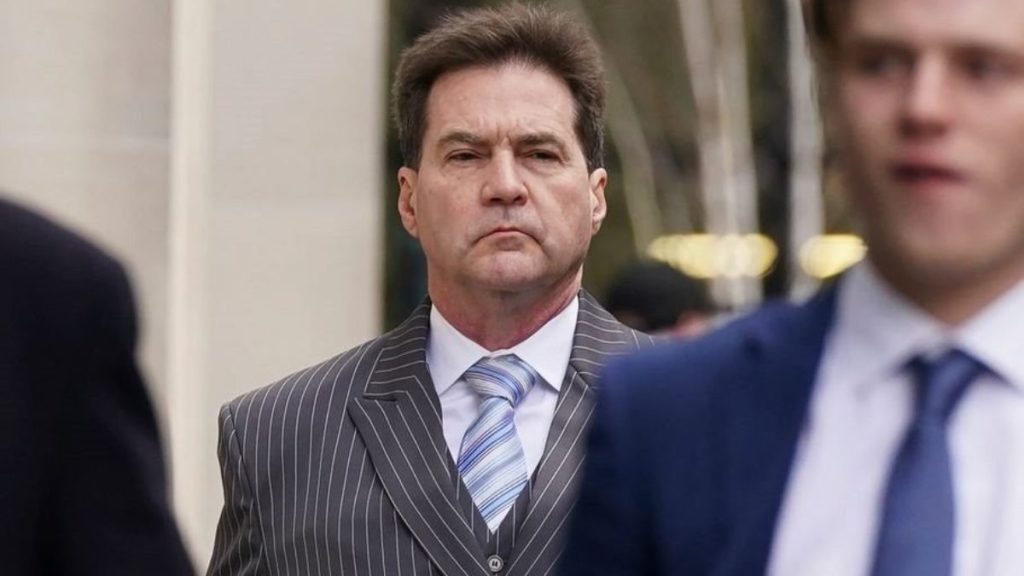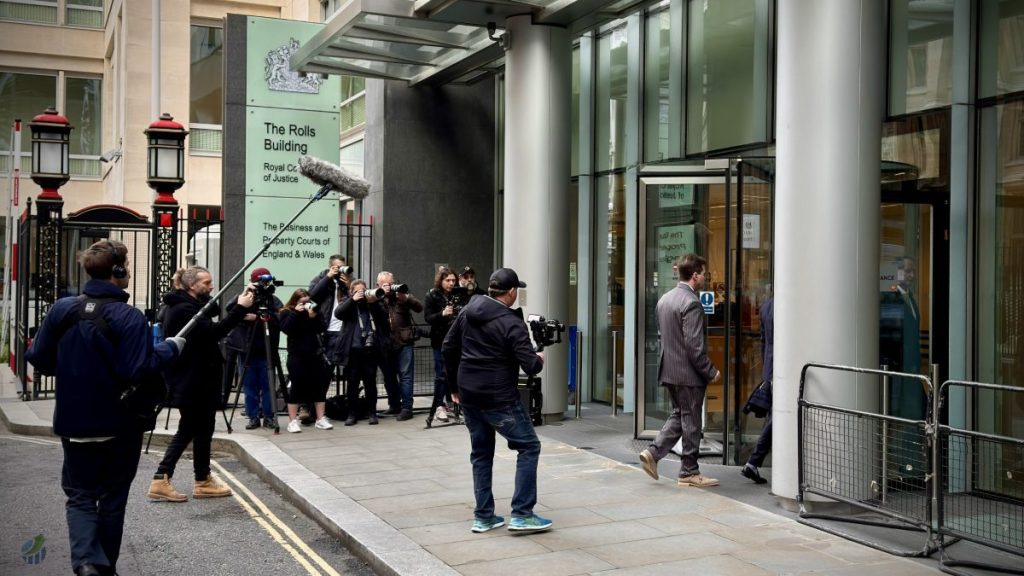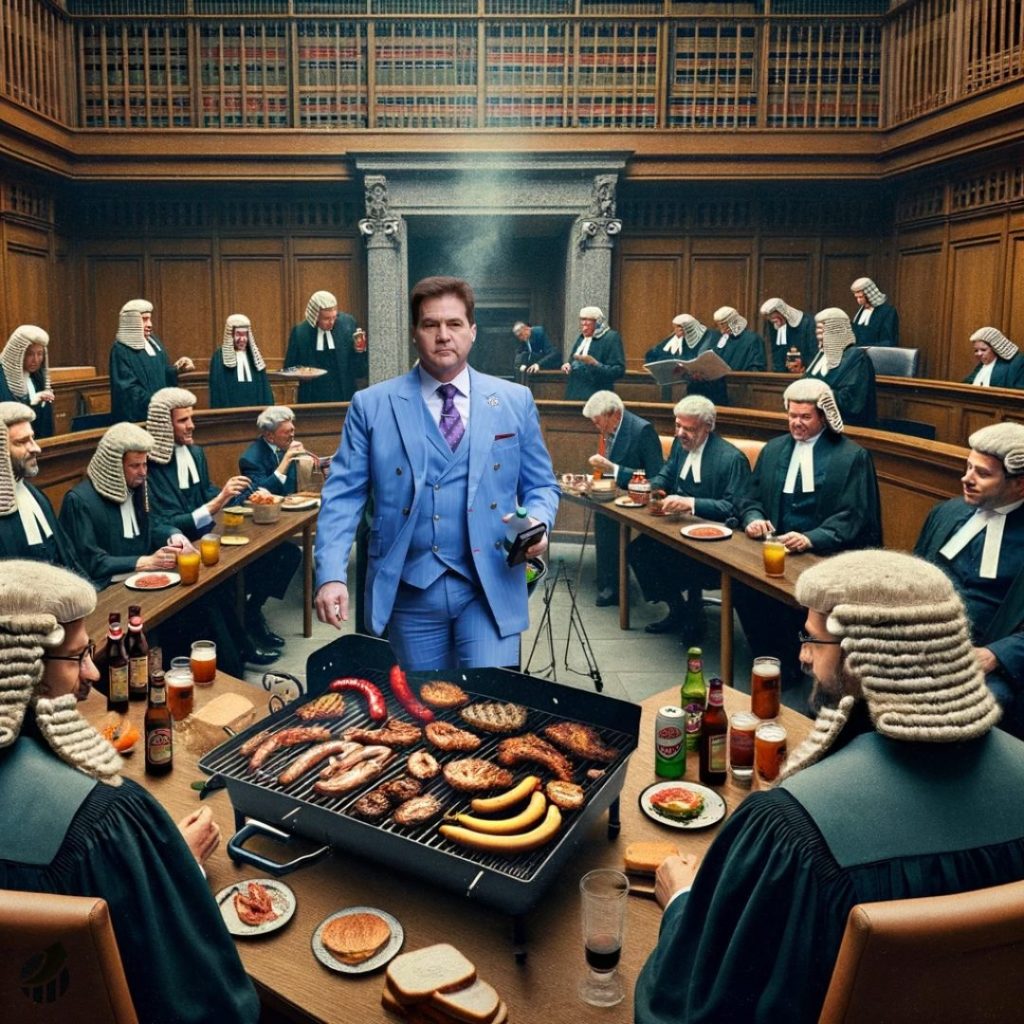Explosive twists in the COPA vs. Wright trial for yet another day. From blame games to bombshell evidence! Day 4 of the trial reveals dramatic shifts in Wright’s defense strategy, as he moves from blaming Citrix MetaFrame to pointing fingers at Ira Kleiman and Atlassian. Plus, a surprising revelation about Calvin Ayre’s involvement!
The day started with an argument about coffee stains and went spiralling down from there. Discover how Judge Mellor’s pointed interventions expose the cracks in Wright’s narrative. Stay tuned for more shocking updates from the courtroom drama that’s keeping the crypto world on the edge of its seats!
Morning Session
Day 4 of the COPA vs. Craig Wright trial in the High Court was marked by an intricate dance of legal argumentation and forensic analysis. Jonathan Hough KC, representing COPA, meticulously dissected the evidence presented by Craig Wright, focusing on a series of screenshots allegedly taken by Ontier, Wright’s legal firm. These screenshots, according to Wright, were part of a later chain-of-custody explanation, but Hough highlighted inconsistencies in their timestamps which pointed to March 9, 2020, raising questions about their creation and Wright’s involvement in their editing.
Wright maintained that he had no control or possession of the documents at the time the edits were made, suggesting that any modifications were out of his hands once he transferred the login to Ontier and AlixPartners in late 2019. This line of defense was met with a probing cross-examination from Hough, who suggested that Wright had modified records before Ontier produced the screenshots, an accusation Wright vehemently denied.
The trial then turned to a physical piece of evidence, a photo of the first page of a version of the white paper with Wright’s name, which was presented with yellow stains and staples, alluding to a plea of forgery. The authenticity of this document was questioned, especially when compared to a similar document with further annotations, including a mention of Stefan Matthews, which could have supported Wright’s claim if proven genuine.
Wright’s relationship with Calvin Ayre, a prominent supporter, was also scrutinized, with Hough questioning whether Ayre had provided financial support for Wright’s legal battles. Wright clarified that what he had received from Ayre was a commercial loan against his assets, which he intended to repay, rather than direct financial backing.
The cross-examination ventured into technical details of document creation, with Hough presenting evidence from an expert witness, Dr. Placks, and challenging Wright’s rebuttals, which Wright dismissed as mere opinion without scientific grounding. Justice Mellor intervened at times, urging Wright to focus on disputing the findings rather than the process.
As the day unfolded, Hough continued to build a narrative of doubt around Wright’s evidence, suggesting that documents had been manipulated and postdated to support Wright’s claims of being the original creator of Bitcoin. Wright’s responses were a mix of technical explanations and challenges to the methodologies of COPA’s expert witnesses, often invoking his extensive academic experience.
Jonathan Hough KC meticulously interrogated Wright over a series of screenshots related to the Bitcoin whitepaper, questioning the authenticity of documents and suggesting that Wright himself had a vested interest in their forgery.
Wright defended his position, arguing that any alterations to the documents’ metadata were trivial and that, given his technical prowess, he could have produced flawless forgeries or altered source code effortlessly. He emphasized the simplicity of his setup, which supposedly allowed him to generate and modify documents with a mere button click, countering claims that manual hex editing indicated a deliberate effort to deceive.
However, as Hough pointed out, expert testimonies were yet to be fully considered, which could potentially unravel Wright’s narrative. The trial delved into the granular details of document generation, with Hough highlighting inconsistencies in IP addresses and server names within the debug.log files generated by Bitcoin software. Wright’s explanations oscillated between technical jargon and layman’s terms, seemingly to maintain the integrity of his narrative.
Further complicating matters, Wright’s explanation for the discrepancy was that documents had been backdated without his knowledge, possibly by a disgruntled ex-employee or as part of a setup by Ira Kleiman, the brother of his late business associate Dave Kleiman. Wright suggested that the chain-of-custody documents would clarify this, though he admitted uncertainty about specific details when pressed by Hough.
The day’s proceedings were punctuated by Wright’s admission of receiving loans rather than outright financial support and his insistence that he was not in control of certain systems, which allegedly led to the creation of compromised documents. The discussion extended to emails purportedly from Satoshi Nakamoto, which Wright claimed were spoofed or otherwise manipulated to support false narratives.

The Afternoon Session
The late session kicked off with Jonathan Hough KC, the COPA barrister, grilling Craig Wright on the hex editing of the bitcoin.exe file. Wright admitted to the hex editing but contended that the altered file had been used against him in the Kleiman case.
The discussion moved to the examination of documents from the Hodlonaut case, where Wright aimed to demonstrate his claim of widespread manipulation of his files and history. However, Hough argued that these documents were presented in the Oslo court to substantiate Wright’s claim to be Satoshi Nakamoto, which Wright disputed. This led to a deeper dive into Wright’s legal representation in Oslo, with Wright expressing dissatisfaction with his lawyers’ actions.
The heart of the session’s debate centered on the authenticity of various documents, including a trust deed linked to Wright and the involvement of several trustees. Wright maintained that the documents had been manipulated and were part of a broader strategy to set him up, a claim he asserted despite previously attesting to their authenticity. This inconsistency was a point of contention, with Hough highlighting discrepancies between Wright’s current testimony and his previous statements.
As the session unfolded, Wright presented a narrative of being a victim of various schemes and forgeries, designed to both defame him and usurp his claims. He described a convoluted situation where assets were moved between trusts and companies to avoid seizure by the Australian Taxation Office (ATO) and to deal with the ramifications of the Kleiman litigation.
Hough’s cross-examination revealed a pattern of Wright’s explanations shifting over time, including changes in the narrative surrounding the formation of trusts and the movement of assets. Wright admitted to being intoxicated when drafting certain trust documents, which he later claimed were part of a manipulated scheme by Ira Kleiman and others.
The session also delved into technical details, with Wright challenging the expert witness reports on the authenticity of various documents, including the Bitcoin source code and a memo on extending BlackNet using the TimeCoin method. Wright stood by his claim that these documents were authentic and that any perceived irregularities were due to third-party tools or server migrations.
COPA barrister Jonathan Hough KC from London-based law firm Bird & Bird kept pressing Craig Wright for clarity on the documents he presented as evidence. Wright maintained that while the work began earlier, he had a functioning version in 2008, and any subsequent prints or edits were still extensions of that original work. This point of contention focused on the continuity and dating of the source code development, with Wright asserting his consistent contribution from 2008 despite updates or lack of precise documentation.
Hough then challenged Wright on the physical copies of the code he claimed to have periodically printed, questioning whether they were indeed the same as the earlier versions or just contained the same content. Wright’s admission to moving out of his home and the resultant lack of proper documentation further complicated the verification of the documents’ timelines.
The discussion delved into the technicalities of software version control and Wright’s methodological approach to updating and printing the source code. Wright’s claim that his proof of being the creator of Bitcoin was not contingent on possessing the original code but rather on his prolific patent output and contribution to nChain was a pivotal moment, reflecting his broader defense strategy.
Hough also introduced evidence from a Bitcoin forum post, suggesting that Wright’s code matched the content and breakpoint of a forum post. Wright disputed the claim that they were the same, arguing that even indentation—a feature of coding syntax and style—contributed to content, thus implying that his work was original and not derived from public posts.

Community Reaction
Norbert, who has been closely covering the trial, provided an interesting perspective on the recent developments. He pointed out a shift in Craig Wright’s defense strategy, moving from blaming Citrix MetaFrame to implicating Ira Kleiman and Atlassian for the alleged forgery of documents. Norbert also highlighted that Calvin Ayre supposedly only provided a loan for the case, not direct funding.
Another significant observation was Wright’s change in narrative, distancing himself from claims of being Satoshi and admitting that much of the evidence he previously relied on was forged. Norbert describes these developments as “MURDER,” a term he learned in the legal proceedings, indicating the drastic nature of these revelations. A notable moment from Judge Mellor was when he questioned Wright about a Speedtest screenshot bearing his name, casting doubt on Wright’s explanations.
Hodlonaut, commenting on the COPA vs. Wright trial, highlighted a potential conflict of interest involving Craig Wright’s business partner, Stefan Matthews. He noted that Matthews reportedly stands to gain a $100 million bonus if Wright wins the case. This situation raises questions about the impartiality of witnesses with substantial financial incentives. Hodlonaut also shared his satisfaction in observing Wright being confronted with his alleged lies and forgeries in court. He expressed a sense of relief and vindication, watching the proceedings unfold.
COPA in a recent statement highlights significant developments in the cross-examination of Craig Wright. They have presented the Court with multiple documents that Wright used to support his claim of being Satoshi Nakamoto, which COPA alleges are forgeries. Wright himself has acknowledged that many of these documents are inauthentic. His explanations for relying on these forgeries have varied, including blaming former solicitors for alleged mistakes, former employees for planting false documents, third parties for hacking his systems, and even suggesting that the IT environment he works in automatically altered his documents.

Furthermore, when questioned about the authenticity of documents related to the alleged Tulip Trust, which were submitted in the US Kleiman litigation, Wright was unable to vouch for their authenticity. He stated, “I have no idea and I cannot vouch for anything being completely real”. This admission seems to bolster COPA’s argument and raises serious doubts about the credibility of Wright’s claim to the Satoshi identity. Wright’s portrayal as an “unfortunate information security expert” is indicative of the challenges he faces in proving his case amidst these allegations and admissions of inauthenticity.
Simon Tennant, reflecting on Day 4 of the COPA vs. Wright trial, portrays a courtroom scenario where Wright’s claims of being Satoshi Nakamoto are increasingly challenged. Tennant suggests that Wright sees himself as an intellectual figure capable of creating Bitcoin, seeking acceptance from the Bitcoin Core community. However, in court, this image is being deconstructed, leading Tennant to liken the situation to the Emperor’s New Clothes, where Wright’s alleged lack of credibility is being exposed.
Tennant acknowledges the seemingly effortless task COPA’s barrister faces, where Wright appears to self-sabotage through his explanations. He notes Wright’s tendency to deflect blame to various external factors and individuals, never accepting fault. The preparation work of Jonathan Hough KC and the Bird & Bird team is highly commended by Tennant for their thoroughness in the face of these challenges.
In many ways COPA has an easy job in this case. The barrister needs to simply open with a question and Wright proceeds to shoot himself in the foot.
— Simon Tennant (@imaginator) February 8, 2024
Christen Ager-Hanssen has come out and made significant claims regarding his involvement. Ager-Hanssen alleged that he never spoke to Mayaka, contradicting statements made in the trial. He allegedly was engaged in a pro bono consulting role for Calvin Ayre, with a substantial success fee contingent on winning the identity trial. This engagement he says, began in May 2023, following concerns about Wright’s legal representation and the overall state of his cases.
During his work, he allegedly uncovered alarming practices by Wright, including emailing himself through fake addresses, deleting incriminating search history, and creating false documents to bolster his claim of being Satoshi Nakamoto. Ager-Hanssen claims to have restored most of the erased data and expresses willingness to bring this information to the court’s attention, suggesting that COPA may find it relevant and legally compliant.
His role in the steering committee, alongside Calvin Ayre and Stefan Matthews, was integral to strategizing Wright’s litigation, he claims. This committee, allegedly established with the mandate of Calvin Ayre as the primary litigation funder, was responsible for all strategic decisions regarding Wright’s legal battles. These revelations, if substantiated, could significantly impact the ongoing legal proceedings and Wright’s claim to the identity of Satoshi Nakamoto.
Reflections on Day 4 of COPA v Wright, the identity issue.
— Norbert ⚡️ (@bitnorbert) February 8, 2024
The blame game shifted from Citrix MetaFrame to Ira Kleiman and Atlassian today.
We learnt that Calvin is supposedly *not* funding this case, he only provided a loan (that money is gone, Calvin).
We saw complete 180s… pic.twitter.com/MAERPYcmcI
The BSV Camp Reaction
Kurt Wuckert Jr, a writer for Calvin Ayre’s Coingeek publication and supporter of Bitcoin SV (BSV), commented on the ongoing trial involving Craig Wright. He acknowledged, what he describes as “excitement” among BSV supporters regarding the trial’s developments but cautioned that the trial is far from over and urged them not to celebrate prematurely. Wuckert Jr. hinted at the possibility of unexpected developments, referring to “Silicon Valley lizards and their laser eye slaves” potentially having undisclosed strategies or ‘aces up their sleeves’.
He encouraged the BSV community to stay focused, indicating the unpredictable nature of such high-profile legal battles and the need for continued attention as the trial progresses over several weeks.
Legal Conclusion
From a legal standpoint, Day 4 of the trial was a critical juncture, particularly concerning the evidentiary challenges faced by Wright’s defense. Wright’s admissions regarding the lack of precise documentation and the possibility of updates to his work without changing the copyright dates highlighted the challenges of proving the provenance of digital creations, which is compounded by the nature of open-source software development and public forums where similar codes can be shared.
The legal strategies employed today aimed to cast doubt on the reliability of Wright’s claims. By juxtaposing the code Wright presented with publicly available versions from Bitcoin forums, the prosecution sought to undermine Wright’s assertions of originality and authorship. Wright’s response, emphasizing the public nature of the code and his continuous work on the project, attempted to reframe the narrative, positioning him as a pivotal contributor to Bitcoin from its inception.
The thorough cross-examination by Hough and Wright’s fluctuating explanations suggests a demanding day for the defense. The legal implications of Wright’s varying accounts and the introduction of forum post comparisons as evidence were potentially damaging. Wright’s acknowledgement of hex editing and other technical alterations to the code files, while not necessarily indicative of misconduct, certainly added complexity to the case from a legal perspective.
Author Profile

- Lucy Walker covers finance, health and beauty since 2014. She has been writing for various online publications.
Latest entries
- June 30, 2025NewsWireBank Savings at Risk: The Dark Side of EU’s Savings Standard
- April 25, 2025Global EconomicsWhistleblowers Unmask Schwab’s Toxic WEF Secrets
- April 9, 2025Global EconomicsTariff Tensions Drive Market Volatility
- March 18, 2025Global EconomicsRed in Name Only: Labour’s War on the UK Working Class



